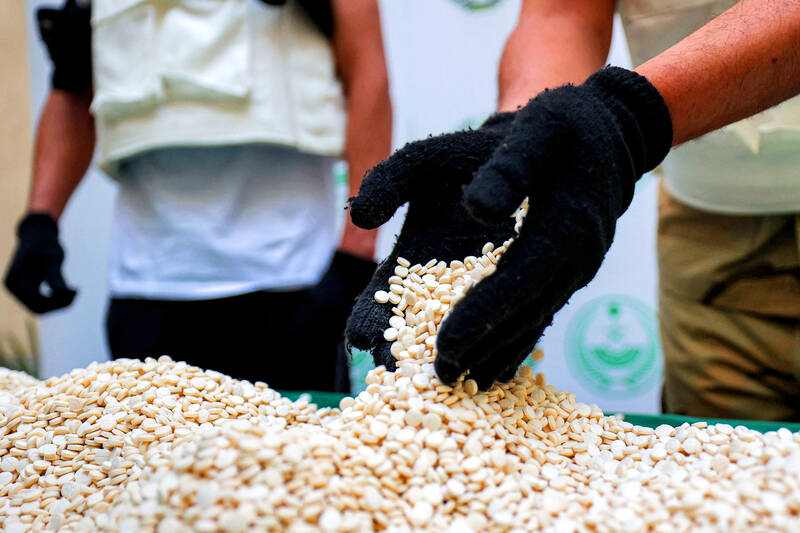The Middle East finds itself caught in the grip of the international drug smuggling epidemic. As drug syndicates seize upon the vulnerabilities and complexities of the region, the repercussions reverberate across its landscapes. Cocaine shipments are smuggled into major shipping ports such as Antwerp and Rotterdam, concealed within legitimate cargo, and subsequently distributed across the Middle East. From there, the drug is further disseminated through established networks, reaching end consumers and fueling the demand for the illicit substance within the region. The Middle East, positioned between production centers and European markets, makes it an attractive transit point and destination for cocaine and other drug smuggling operations. In January 2021, UAE authorities announced the arrest of an international drug trafficking gang, seizing approximately 1.7 million Captagon pills, which were hidden inside wooden panels being transported via sea containers.
The Middle East is now grappling with not only the staggering influx of narcotics but the mounting socio-economic consequences, surging addiction rates, and an alarming strain on security forces. The challenge will only get worse as drug routes become increasingly intertwined with other illicit activities, including terrorism financing and money laundering. To stem the tide will require an integrated response between regional, national, and international authorities.
The problem with ports
Ports have proven to be critical nodes in global trade and transportation networks, making them attractive to drug smugglers because they provide easy access to international shipping routes. Ports such as Antwerp and Rotterdam are strategically located in Europe, a highly lucrative market for drugs, and are known for their extensive infrastructure and large shipping volumes.
Millions of containers of cargo pass through these ports each year, which makes it almost impossible for authorities to thoroughly inspect each shipment. Despite efforts to enhance security measures, the sheer volume exceeds the capacity of authorities to inspect every shipment thoroughly. Criminal organizations calculate that their overall profits from successful shipments will compensate for losses if their shipment is detected and that their chances of being caught are relatively low.
Containers themselves provide an ideal hiding place for illicit substances. Criminal organizations conceal drugs within legitimate cargo or modify containers, vehicles, or other transport modes to include hidden compartments where drugs can be concealed. They have been known to hollow out fruits or vegetables such as pineapples, melons, or peppers and fill them with drugs. In some instances, they attempt to mask the odor of drugs by using chemical substances or masking agents to confuse drug-detection dogs or interfere with the accuracy of drug-detection technologies.
Corruption within port facilities also poses a grave threat to drug interdiction efforts. Criminal organizations leverage their financial resources to bribe port officials so they might gain insider information, bypass security checks, and receive timely warnings about law enforcement activities. This bribery perpetuates a cycle of criminality and undermines the integrity of port systems, amplifying the challenges faced by authorities.
Cartel logistics: How they get away with it
These drugs primarily originate from regions such as Latin America, particularly Colombia for cocaine, and the Golden Crescent (Afghanistan, Iran, and Pakistan) for heroin. Various criminal syndicates, gangs, and cartels are involved in shipping these drugs. Colombian drug cartels, such as the Cali and Medellín cartels, have historically played a significant role in cocaine trafficking. They have established extensive networks for production, transportation, and distribution, and often use the ports of Antwerp and Rotterdam as entry points into Europe. Mexican drug cartels, including the Sinaloa Cartel and Jalisco New Generation Cartel, are also heavily involved in the smuggling of drugs into Europe. These cartels control large portions of the drug production and trafficking industry in Latin America and utilize their networks to ship drugs to European markets. European organized crime groups, such as the Italian Mafia and Balkan criminal networks, also have well-established networks and connections that facilitate the transportation and distribution of illicit drugs through Europe and beyond.
The offloading of drugs at sea, away from traditional port facilities, has emerged as an effective technique for criminal networks. This method reduces the risk of detection, as it bypasses traditional port inspections and surveillance systems. Criminal gangs utilize small boats or fishing vessels to rendezvous with larger ships offshore, transferring illicit substances discreetly. This practice further complicates the already challenging task of intercepting drug shipments, highlighting the adaptability of criminal networks.
Drug smugglers constantly seek alternative routes to evade law enforcement agencies, often using less-busy ports and transportation routes to diversify their smuggling operations. By employing lesser-known ports or using less scrutinized modes of transportation such as air cargo, rail networks, or road routes, criminals can minimize their risk of interception. These alternative routes pose challenges for law enforcement agencies, which must adapt their strategies to combat evolving smuggling tactics.
Stopping the smuggle
Understanding the significance and importance of these logistics is crucial for law enforcement agencies in developing effective strategies to combat drug trafficking. Customs officials employ an array of sophisticated strategies and cutting-edge technologies such as X-ray scanners, gamma-ray scanners, and density meters to detect concealed drug shipments, but the battle against the flow of drugs transiting through ports like Antwerp and Rotterdam remains an uphill struggle. These officials simply do not have the manpower to individually inspect each container given the sheer volume of merchandise passing through these ports.
Collaborative efforts, improved intelligence sharing, and enhanced security measures at ports are essential to disrupt these illicit operations and protect society from the devastating consequences of drug smuggling.
Dr. Kristian Alexander is a Senior Fellow and the Director of International Security & Terrorism Program at TRENDS Research and Advisory (Dubai).
Image Credit: AFP



















